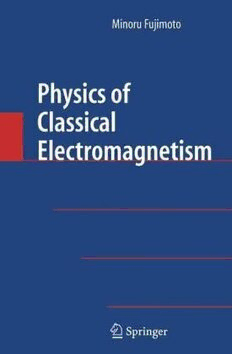Table Of ContentPhysics of Classical Electromagnetism
Minoru Fujimoto
Physics of Classical
Electromagnetism
MinoruFujimoto
DepartmentofPhysics
UniversityofGuelph
Guelph,Ontario
Canada,N1G2W1
LibraryofCongressControlNumber:2007921094
ISBN:978-0-387-68015-6 e-ISBN:978-0-387-68018-7
Printedonacid-freepaper.
(cid:2)C 2007SpringerScience+BusinessMedia,LLC
Allrightsreserved.Thisworkmaynotbetranslatedorcopiedinwholeorinpartwithoutthewritten
permissionofthepublisher(SpringerScience+BusinessMedia,LLC,233SpringStreet,NewYork,
NY10013,USA),exceptforbriefexcerptsinconnectionwithreviewsorscholarlyanalysis.Use
in connection with any form of information storage and retrieval, electronic adaptation, computer
software,orbysimilarordissimilarmethodologynowknownorhereafterdevelopedisforbidden.
Theuseinthispublicationoftradenames,trademarks,servicemarks,andsimilarterms,evenifthey
arenotidentifiedassuch,isnottobetakenasanexpressionofopinionastowhetherornottheyare
subjecttoproprietaryrights.
9 8 7 6 5 4 3 2 1
springer.com
Contents
Preface.................................................................................... xi
1. SteadyElectricCurrents......................................................... 1
1.1. Introduction.................................................................. 1
1.2. StandardsforElectricVoltagesandCurrent........................... 2
1.3. OhmLaw’sandHeatEnergy............................................. 4
1.4. TheKirchhoffTheorem.................................................... 8
PART1. ELECTROSTATICS 13
2. ElectrostaticFields................................................................ 15
2.1. StaticChargesandTheirInteractions................................... 15
2.2. ATransientCurrentandStaticCharges................................ 16
2.3. UniformElectricFieldinaParallel-PlateCondenser................ 19
2.3.1. TheElectricFieldVector......................................... 19
2.3.2. TheFluxDensityVector.......................................... 21
2.4. ParallelandSeriesConnectionsofCapacitors........................ 25
2.5. InsulatingMaterials........................................................ 26
3. TheGaussTheorem.............................................................. 30
3.1. ASphericalCapacitor...................................................... 30
3.2. ACylindricalCapacitor................................................... 33
3.3. TheGaussTheorem........................................................ 34
3.4. BoundaryConditions....................................................... 39
3.4.1. AConductingBoundary.......................................... 39
3.4.2. ADielectricBoundary ............................................ 40
4. TheLaplace–PoissonEquations................................................ 43
4.1. TheElectrostaticPotential................................................ 43
4.2. TheGaussTheoreminDifferentialForm.............................. 44
4.3. CurvilinearCoordinates(1)............................................... 46
v
vi Contents
4.4. TheLaplace–PoissonEquations ......................................... 49
4.4.1. BoundaryConditions.............................................. 49
4.4.2. UniquenessTheorem.............................................. 50
4.4.3. Green’sFunctionMethod......................................... 51
4.5. SimpleExamples............................................................ 53
4.6. TheCoulombPotential.................................................... 55
4.7. PointChargesandtheSuperpositionPrinciple........................ 58
4.7.1. AnElectricImage.................................................. 58
4.7.2. ElectricDipoleMoment........................................... 60
4.7.3. TheDipole-DipoleInteraction................................... 63
5. TheLegendreExpansionofPotentials........................................ 64
5.1. TheLaplaceEquationinSphericalCoordinates...................... 64
5.2. SeriesExpansionoftheCoulombPotential............................ 66
5.3. Legendre’sPolynomials................................................... 68
5.4. AConductingSphereinaUniformField.............................. 69
5.5. ADielectricSphereinaUniformField................................. 71
5.6. APointChargeNearaGroundedConductingSphere............... 72
5.7. ASimpleQuadrupole...................................................... 75
5.8. AssociatedLegendrePolynomials....................................... 76
5.9. MultipolePotentials........................................................ 79
PART2. ELECTROMAGNETISM 83
6. TheAmpe`reLaw.................................................................. 85
6.1. Introduction.................................................................. 85
6.2. TheAmpe`reLaw............................................................ 86
6.3. ALongSolenoid............................................................ 89
6.4. Stokes’Theorem............................................................ 91
6.5. CurvilinearCoordinates(2)............................................... 94
6.6. TheAmpe`reLawinDifferentialForm.................................. 96
6.7. TheRowlandExperiment................................................. 98
7. MagneticInduction............................................................... 101
7.1. LawsofMagneticInduction.............................................. 101
7.1.1. TheFaradayLaw................................................... 101
7.1.2. TheLenzLaw....................................................... 103
7.1.3. MagneticFieldVectors............................................ 103
7.2. DifferentialLawofInductionandtheDynamicElectricField..... 104
7.3. MagneticMoments......................................................... 108
8. ScalarandVectorPotentials..................................................... 112
8.1. Magnets....................................................................... 112
8.2. Pohl’sMagneticPotentiometer........................................... 114
Contents vii
8.3. ScalarPotentialsofMagnets............................................ 116
8.3.1. ALaboratoryMagnet........................................... 116
8.3.2. AUniformlyMagnetizedSphere............................. 118
8.4. VectorPotentials........................................................... 119
8.5. ExamplesofSteadyMagneticFields.................................. 121
8.6. VectorandScalarPotentialsofaMagneticMoment............... 126
8.7. MagnetismofaBohr’sAtom........................................... 128
9. InductancesandMagneticEnergies........................................... 132
9.1. Inductances................................................................. 132
9.2. Self-andMutualInductances........................................... 135
9.3. MutualInteractionForceBetweenCurrents.......................... 138
9.4. ExamplesofMutualInduction.......................................... 139
9.4.1. ParallelCurrents................................................. 139
9.4.2. TwoRingCurrents.............................................. 140
10. Time-DependentCurrents ...................................................... 142
10.1. ContinuityofChargeandCurrent...................................... 142
10.2. AlternatingCurrents...................................................... 143
10.3. Impedances................................................................. 145
10.4. ComplexVectorDiagrams............................................... 147
10.5. Resonances................................................................. 149
10.5.1. AFreeLCOscillation.......................................... 149
10.5.2. SeriesResonance ............................................... 150
10.5.3. ParallelResonance.............................................. 151
10.6. Four-TerminalNetworks................................................. 152
10.6.1. RCNetwork...................................................... 153
10.6.2. LoadedTransformer............................................ 155
10.6.3. AnInput-OutputRelationinaSeriesRCLCircuit........ 156
10.6.4. FreeOscillationinanRCLCircuit .......................... 157
PART3. ELECTROMAGNETICWAVES 159
11. TransmissionLines............................................................... 161
11.1. Self-SustainedOscillators............................................... 161
11.2. TransmissionLines........................................................ 163
11.3. FourierTransforms........................................................ 165
11.4. ReflectionandStandingWaves......................................... 167
11.5. TheSmithChart........................................................... 170
12. TheMaxwellEquations ......................................................... 172
12.1. TheMaxwellEquations.................................................. 172
12.2. ElectromagneticEnergyandthePoyntingTheorem................ 175
12.3. VectorandScalarPotentials............................................. 176
viii Contents
12.4. RetardedPotentials........................................................ 177
12.5. MultipoleExpansion...................................................... 180
13. ElectromagneticRadiation...................................................... 184
13.1. DipoleAntenna............................................................ 184
13.2. ElectricDipoleRadiation................................................ 184
13.3. TheHertzVector.......................................................... 188
13.4. AHalf-WaveAntenna.................................................... 192
13.5. ALoopAntenna........................................................... 193
13.6. PlaneWavesinFreeSpace.............................................. 195
14. TheSpecialTheoryofRelativity............................................... 199
14.1. Newton’sLawsofMechanics........................................... 199
14.2. TheMichelson–MorleyExperiment................................... 200
14.3. TheLorentzTransformation............................................ 202
14.4. VelocityandAccelerationinFour-DimensionalSpace............ 204
14.5. RelativisticEquationofMotion........................................ 206
14.6. TheElectromagneticFieldinFour-DimensionalSpace............ 208
15. WavesandBoundaryProblems................................................. 214
15.1. SkinDepths................................................................. 214
15.2. PlaneElectromagneticWavesinaConductingMedium........... 216
15.3. BoundaryConditionsforPropagatingWaves........................ 218
15.4. ReflectionfromaConductingBoundary.............................. 219
15.5. DielectricBoundaries..................................................... 221
15.6. TheFresnelFormula...................................................... 223
16. GuidedWaves...................................................................... 226
16.1. PropagationBetweenParallelConductingPlates................... 226
16.2. UniformWaveguides..................................................... 229
16.2.1. TransversalModesofPropagation
(TEandTMModes)............................................ 229
16.2.2. TransversalElectric-MagneticModes(TEM)............. 232
16.3. ExamplesofWaveguides................................................ 233
PART4. COHERENTWAVESANDRADIATIONQUANTA 241
17. WaveguideTransmission........................................................ 243
17.1. OrthogonalityRelationsofWaveguideModes....................... 243
17.2. Impedances................................................................. 245
17.3. PowerTransmissionThroughaWaveguide.......................... 249
17.4. MultipleReflectionsinaWaveguide.................................. 250
18. ResonantCavities................................................................. 253
18.1. Slater’sTheoryofNormalModes...................................... 253
18.2. TheMaxwellEquationsinaCavity.................................... 256
Contents ix
18.3. FreeandDampedOscillations.......................................... 258
18.4. InputImpedanceofaCavity............................................ 260
18.5. ExampleofaResonantCavity.......................................... 263
18.6. MeasurementsofaCavityResonance................................. 265
19. ElectronicExcitationofCavityOscillations................................. 268
19.1. ElectronicAdmittance.................................................... 268
19.2. AKlystronCavity......................................................... 270
19.3. VelocityModulation...................................................... 274
19.4. AReflexOscillator........................................................ 276
20. DielectricandMagneticResponsesinResonantElectromagneticFields 280
20.1. Introduction................................................................. 280
20.2. TheKramers–Kro¨nigFormula.......................................... 281
20.3. DielectricRelaxation..................................................... 283
20.4. MagneticResonance ..................................................... 288
20.5. TheBlochTheory......................................................... 290
20.6. MagneticSusceptibilityMeasuredbyResonanceExperiments.. 292
21. LaserOscillations,PhaseCoherence,andPhotons......................... 294
21.1. OpticalResonators........................................................ 294
21.2. QuantumTransitions...................................................... 296
21.3. InvertedPopulationandtheNegativeTemperature................. 299
21.4. AmmoniumMaser........................................................ 300
21.5. CoherentLightEmissionfromaGasLaser.......................... 301
21.6. PhaseCoherenceandRadiationQuanta.............................. 302
APPENDIX 305
MathematicalNotes.................................................................... 307
A.1. OrthogonalVectorSpace....................................................... 307
A.2. OrthogonalityofLegendre’sPolynomials.................................. 308
A.3. AssociatedLegendrePolynomials............................................ 310
A.4. FourierExpansionandWaveEquations..................................... 312
A.5. Bessel’sFunctions............................................................... 314
REFERENCES 317
Index...................................................................................... 319
Preface
TheMaxwelltheoryofelectromagnetismwaswellestablishedinthelatternine-
teenth century, when H. R. Hertz demonstrated the electromagnetic wave. The
theory laid the foundation for physical optics, from which the quantum concept
emergedformicroscopicphysics.Einsteinrealizedthatthespeedofelectromag-
netic propagation is a universal constant, and thereby recognized the Maxwell
equationstocomposeafundamentallawinallinertialsystemsofreference.On
the other hand, the pressing demand for efficient radar systems during WWII
acceleratedstudiesonguidedwaves,resultingintoday’sadvancedtelecommuni-
cationtechnology,inadditiontoanewradio-andmicrowavespectroscopy.The
studieswerefurtherextendedtoopticalfrequencies,andlaserelectronicsandso-
phisticatedsemi-conductingdevicesarenowfamiliarindailylife.Owingtothese
advances,ourknowledgeofelectromagneticradiationhasbeensignificantlyup-
graded beyond plane waves in free space. Nevertheless, in the learning process
the basic theory remains founded upon early empirical rules, and the traditional
teachingshouldthereforebemodernizedaccordingtoprioritiesinthemodernera.
Inspiteofthefactthattherearemanybooksavailableonthiswell-established
theme,Iwasmotivatedtowritethisbook,reviewingthelawsintermsofcontem-
poraryknowledgeinordertodealwithmodernapplications.HereIfollowedtwo
basicguidelines.First,Iconsideredelectronicchargeandspinasempiricalinthe
descriptionofelectromagnetism.Thisisunliketheviewofearlyphysicists,who
considered these ideas hypothetical. Today we know they are factual, although
stillunexplainedfromfirstprinciple.Second,theconceptof“fields”shouldbein
theforefrontofdiscussion,asintroducedbyFaraday.IntheseregardsIbenefited
from Professor Pohl’s textbook, Elektrizita¨tslehre, where I found a very stimu-
latingapproach.Owingagreatdealtohim,Iwasabletowritemyintroductory
chapters in a rather untraditional way, an approach I have found very useful in
myclasses.Inaddition,inthisbookIdiscussedmicrowaveandlaserelectronics
insomedepth,areaswherecoherentradiationplaysasignificantroleformodern
telecommunication.
Iwrotethisbookprimarilyforstudentsatupperundergraduatelevels,hoping
it would serve as a useful reference as well. I emphasized the physics of elec-
tromagnetism,leavingmathematicaldetailstowritersofbookson“mathematical
xi

